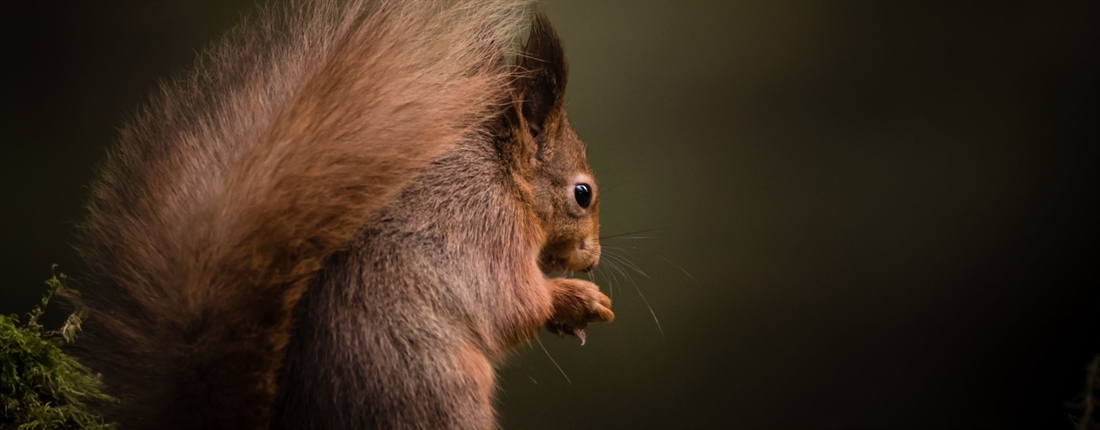The red squirrel frontline
Julia Stoddart on the key work red squirrel conservation groups are carrying out and why it is so necessary

Beatrix Potter, author of the Tale of Squirrel Nutkin, once implored us to “Believe there is a great power silently working all things for good.” First published in 1903, Nutkin’s story arrived just as his great enemy, the grey squirrel, was being released from sites in England and Scotland to begin its inexorable colonisation. Looking back on the greys’ rapid progression from its original 1890s introduction and subsequent release sites, it is difficult to reconcile this conservation disaster with the silent, benevolent power of Potter’s quote. At the time of writing, estimates put the UK red squirrel population at no more than 140,000, while the number of grey squirrels is around 2.5 million. But all is not yet lost: there is indeed a power working to redress the balance, albeit not always silently.
Regardless of the bizarre protestations of some animal rights proponents, it is an indisputable fact that the introduction of grey squirrels to the UK and the species’ ensuing spread placed our native red squirrel into serious jeopardy. Most readers will be aware of the damaging interactions between the two: grey squirrels out-compete our reds for food and habitat, and they are more adaptable and opportunistic at locating and exploiting food resources. In addition, grey squirrels are a major vector in the spread of squirrel pox; a vile disease that kills red squirrels while the carrier greys remain unaffected. To add insult to injury, there is evidence to suggest that grey squirrels dig up and eat winter food stores buried by red squirrels; this in turn impacts the health and survival rate of both adult and juvenile reds. The problems caused by greys are amplified by fragmentation and reduction of suitable red squirrel habitat across the country.
The facts are damning: as a report from the UK Trapping Mammals Partnership stated, “A major invasive species, the grey squirrel has been the primary cause of red squirrel population declines across the UK.” Greys have many other negative effects on our ecosystem and economy; from bark stripping in woodlands to predating the nests of vulnerable bird species, the charge sheet is extensive. By the 1930s, the number of grey squirrels and their impacts were of such concern that the Forestry Commission introduced a bounty system, initially paying sixpence a tail. After a hiatus during the Second World War the scheme recommenced, but finally ceased in 1958 as authorities realised that the strategy was not resulting in a grey squirrel population reduction. Interestingly, a government grey squirrel bounty has been re-examined over the years, but concerns over public perception and safety seem to have consigned it to history. It is unlikely that grey squirrels will ever be exterminated from the UK. Urban strongholds and the sheer scale of the problem mean that the focus is now on protecting areas where red squirrels still survive. Culling greys might not guarantee their fundamental decline, but consistently removing individuals from the population may prevent further expansion.
What does it take to kill a grey squirrel? It is perfectly possible for members of the public who have no previous experience of lethal control of mammals to become trained in trapping and dispatch methods, if they are able to process the reality of taking a life. But better placed are those who already have the skills needed to operate traps and dispatch greys using firearm or priest. These people are the keepers and the hunterconservationists that belong to our fieldsports community.
I was recently shown a 1964 entry in the fascinating record book of the Wartling Hill Grey Squirrel Club; at the bottom of the entry: “This made the club’s total of squirrels killed 1949 to 1964 = 5,657.” Many pages later, by 1980 the total had risen to 8,022 grey squirrels in this one corner of Sussex; a long-serving club member had been actively controlling greys for 30 years. This kind of dedication and efficiency is characteristic of our people.
Further north, grey squirrel controller Brian Fishwick is a retired keeper who now utilises his professional skills as a red squirrel conservation volunteer. Brian moved to Scotland from Northern England, and the local squirrel conservation group was already aware of his particular set of skills when he arrived: “At first I was asked when visiting if I could trap for a few days. At that time, the local red squirrel group had four keepers involved as volunteers in trapping – two ex-keepers and two still working. It was pretty obvious the keepers’ skill-set was ideally suited to preventing the demise of the red squirrel.”
Brian runs successful traps, and also uses feeding stations in order to bring greys in to be shot: “This is testing in woodland where you have to be ultra-sure it’s a grey before pulling the trigger. No drey-poking here!” So efficient is Brian’s keeper-mentality that the annual cull figure now sits around 40, “but it’s amazing how much more effort is required even though the figures are much smaller than when I started. At times of high densities of greys, the trapping is relatively easy, however when the numbers are reduced to the last few they can really test your trapping and tracking skills, and patience!” And so we see the importance of having extensive on-the-ground experience at the coalface of wildlife management.
Our community often speaks about the value of our conservation work, paid for out of our own pockets because we understand that a healthy environment is vital for everyone. It is reliably estimated that our work amounts to considerably more than that of all the so-called nature charities combined. And where squirrels are concerned, the results speak for themselves; says Brian: “I firmly believe had myself and the other keepers not removed 450 grey squirrels at a critical time in 2015, the red squirrel would be as good as extinct in my area.”
Around the country, red squirrel conservation groups are operating on the red squirrel frontline to protect our natural heritage. Integral to these essential groups are stalwarts from the fieldsports community who are simply getting the job done. Their work may not be silent, but they are undoubtedly working for the greater good.
Related Articles
Get the latest news delivered direct to your door
Subscribe to Fieldsports Journal
Elevate your experience in the field with a subscription to Fieldsports Journal, the premium publication for passionate country sports enthusiasts. This bi-monthly journal delivers unparalleled coverage of game shooting, fishing and big game across the UK and beyond.
Each issue offers a stunning collection of in-depth features, expert opinions and world-class photography, all presented in a timeless yet contemporary design.
Save 10% on shop price when you subscribe, with a choice of packages that work for you. Choose from Print & Digital or Digital only with each journal delivered directly to your door or via the app every other month, plus access to past issues with the digital back issue library.







